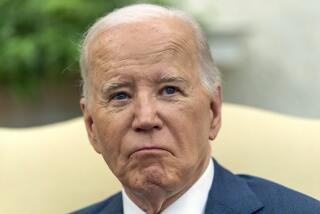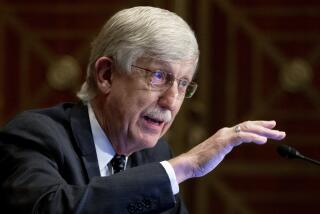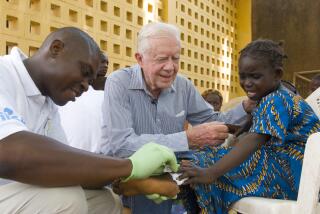Bush seeks boost in AIDS spending
- Share via
WASHINGTON — President Bush said Wednesday that he would ask Congress to increase U.S. support for the global fight against HIV/AIDS to $30 billion over five years from the current commitment of $15 billion.
The White House estimates the increased spending would treat 2.5 million people, prevent 12 million infections and provide additional care for 12 million people, among them 5 million orphans and other children.
In the program’s first three years, through March, it helped pay for treatment of 1.1 million people in 15 countries, nearly all of them in Africa.
“This level of assistance is unprecedented, and the largest commitment by any nation to combat a single disease,” Bush said of the initial five-year program. “This investment has yielded the best possible return: saved lives.”
In a speech in the White House Rose Garden, Bush said, “It’s important that we continue the work we have begun.”
The program, which is up for renewal in 2008, is one of the rare Bush initiatives that has won praise from a wide swath of the political spectrum.
Rep. Barbara Lee (D-Oakland), a frequent critic of Bush policies and one of the original sponsors of the plan in 2003, applauded the president for seeking expanded funding but said he needed to go further.
She said the government also should boost spending on malaria and tuberculosis, and on related efforts that were not part of the program but could bolster the fight against HIV/AIDS, including education, nutrition, water, food security and healthcare workers.
In a statement, Lee also took issue with the Bush program’s emphasis on pre-marriage sexual abstinence. A report by the Institute of Medicine said that such restrictions had “greatly limited” specialists trying to carry out prevention programs among those at greatest risk.
Under the Bush program, known as the U.S. President’s Emergency Plan for AIDS Relief, 20% of the funding is dedicated to AIDS prevention, and one-third of that goes to programs that promote abstinence until marriage.
Dr. Mark R. Dybul, the U.S. global aids coordinator, said in a conference call with reporters that the five-year program also had provided 1.3 billion condoms, and that it had taken “a balanced approach.”
He said the proposal would double spending on HIV/AIDS to $30 billion over five years even though the White House had requested only about $5 billion for the next fiscal year, which begins in October.
Asia Russell, director of international policy at Health GAP, an advocacy group funded by private donations and foundations that is fighting AIDS in developing countries, said the Bush request amounted to funding at the current level and would not keep pace with the AIDS epidemic.
She said Bush promised when he began the program that by 2008 it would treat 2 million people with AIDS, about one-third of those in urgent need, and had supported international promises for universal access to HIV treatment and prevention. Her organization estimates that such a course would need a $50-billion U.S. commitment over the next five years.
The president, who wore an HIV/AIDS ribbon in the left lapel of his suit, said First Lady Laura Bush would visit with community leaders and participants in HIV/AIDS programs at the end of June in Zambia, Senegal, Mali and Mozambique.
Bush was joined by Kunene Tantoh, who, the president said, is HIV-positive and runs a U.S.-supported mentoring program for mothers with HIV in Cape Town, South Africa.
As he finished speaking, Bush scooped up Tantoh’s son Baron, 4, who had run up to join them.
The U.S.-funded program operates in Botswana, Ivory Coast, Ethiopia, Guyana, Haiti, Kenya, Mozambique, Namibia, Nigeria, Rwanda, South Africa, Tanzania, Uganda, Vietnam and Zambia.
*
*
Begin text of infobox
Where the money has gone
In 2003, President Bush started a five-year, $15-billion initiative to support global HIV/AIDS treatment, research and prevention. The program, which is up for renewal next year, has:
* Helped pay for the treatment of 1.1 million people in 15 countries, nearly all of them in Africa
* Provided services to prevent mother-to-child HIV transmission during more than 6 million pregnancies
* Provided antiretroviral prophylaxis for women during more than 500,000 pregnancies
* Prevented an estimated 100,000-plus infant infections
* Gone to care for nearly 4.5 million people, including more than 2 million orphans and vulnerable people
* Paid for more than 18 million counseling and testing sessions for men, women and children
*
Source: U.S. President’s Emergency Plan for AIDS Relief
More to Read
Sign up for Essential California
The most important California stories and recommendations in your inbox every morning.
You may occasionally receive promotional content from the Los Angeles Times.










